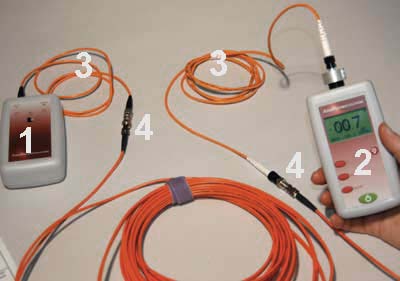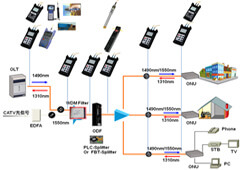Your questions answered about fibre testing equipment in networking
Wiki Article
Exploring the Influence of Robotic Vision on Modern Manufacturing Techniques and Quality Assurance
Robotic vision innovation is transforming the landscape of modern-day manufacturing and quality assurance. By incorporating innovative imaging systems and artificial knowledge, manufacturers can achieve unprecedented levels of precision and performance. This change not just enhances production processes however likewise addresses critical difficulties in preserving product standards. As markets progressively depend on these developments, the effects for future production techniques continue to be to be fully checked out. What will this imply for the competitive characteristics of the marketplace?Recognizing Robotic Vision Modern Technology
Robotic vision technology works as the backbone of automation in modern-day manufacturing. It encompasses the use of video cameras, sensing units, and man-made intelligence to make it possible for robotics to analyze and reply to visual details from their environment. This modern technology enables robots to determine, find, and review objects, making them efficient in carrying out complicated jobs such as setting up, assessment, and product handling with accuracy. The assimilation of artificial intelligence formulas even more boosts the ability of robot vision systems, enabling them to adapt to varying conditions and boost gradually. By processing pictures and data in real-time, robotic vision systems can promote much faster decision-making and reduce mistakes in manufacturing procedures (optical measurement system). This modern technology not only enhances functional effectiveness yet also ensures that quality criteria are fulfilled constantly. As the manufacturing landscape continues to advance, understanding the details of robot vision technology becomes vital for leveraging its potential completelyAdvantages of Robotic Vision in Production
Robotic vision technology offers substantial advantages in production by improving accuracy and precision in tasks such as quality assurance and assembly. This raised degree of information assurances that items fulfill rigorous requirements, minimizing waste and remodel. Additionally, the assimilation of robot vision can result in enhanced production effectiveness, permitting producers to optimize their processes and attain higher result rates.Enhanced Precision and Accuracy
In contemporary production, improved precision and accuracy are critical for maximizing production procedures and making certain item high quality. Robotic vision systems allow equipments to perform intricate tasks with amazing uniformity. These systems make use of innovative imaging modern technologies to spot minute details and variants in materials, parts, and ended up products. By analyzing aesthetic information in real-time, robot vision substantially decreases human mistake, causing fewer defects and better criteria. Furthermore, boosted accuracy in measurements and placing facilitates better alignment in assembly processes, which is essential for elaborate designs. Ultimately, the assimilation of robotic vision not only boosts the reliability of making outputs but likewise promotes confidence among consumers pertaining to product honesty and efficiency. This precision is crucial in sectors where quality is vital.Increased Production Efficiency

Manufacturers are significantly transforming to vision systems to enhance manufacturing performance across various processes. These advanced systems make it possible for real-time inspection and monitoring, substantially minimizing downtime triggered by mistakes or issues. By integrating robotic vision, companies can automate quality assurance, permitting faster identification of concerns and lessening the requirement for human treatment. This causes streamlined operations, as robots can quickly adapt to modifications in manufacturing needs without sacrificing precision. Vision systems promote much better stock administration by accurately tracking components and products, ensuring suitable resource usage. Eventually, the fostering of robot vision not only improves effectiveness but likewise adds to greater output rates, lowered functional costs, and boosted general productivity in the manufacturing industry.
Enhancing Quality Control Processes
Robotic vision modern technology greatly enhances high quality control procedures in production by utilizing accuracy inspection techniques. These advanced systems facilitate real-time problem detection, guaranteeing that items satisfy rigorous top quality requirements. Consequently, producers can reduce waste and boost general efficiency.Precision Examination Techniques
Precision examination techniques have reinvented quality control processes in manufacturing, allowing the detection of minute issues that conventional methods may neglect. These strategies utilize advanced imaging modern technologies, such as high-resolution video cameras and laser scanning, to attain unmatched accuracy. By utilizing robotic vision systems, makers can automate inspection tasks, making sure consistent efficiency and minimizing human error. The integration of artificial intelligence formulas additionally enhances these systems, optical fibre diameter analyser permitting them to adjust and boost over time. Furthermore, accuracy examination assists in the recognition of subtle variations in product measurements and surface finishes, which can greatly affect total item high quality. Therefore, producers can implement restorative activities more swiftly, eventually resulting in lowered waste and improved customer fulfillment.Real-Time Defect Discovery
Using innovative imaging modern technologies, real-time flaw detection transforms quality assurance procedures in manufacturing. By integrating high-resolution electronic cameras and sophisticated formulas, makers can swiftly determine anomalies throughout manufacturing. This modern technology promotes prompt rehabilitative actions, minimizing waste and boosting overall effectiveness. Real-time systems assess products as they relocate along the production line, ensuring that defects are identified and resolved right away production routines. Furthermore, the application of artificial intelligence enhances the precision of these systems, permitting them to adapt to new problem patterns in time. Manufacturers benefit from improved product top quality and lowered functional expenses. Ultimately, real-time issue discovery not only enhances processes however additionally promotes a culture of continual renovation in modern production atmospheres.Real-Time Data Evaluation and Choice Making
In the dynamic landscape of manufacturing, real-time information analysis equips systems to make swift, educated decisions. By leveraging innovative robotic vision technologies, producers can gather and process large quantities of data instantly. These systems examine aesthetic inputs to keep track of production procedures, making sure that any inconsistencies from high quality requirements are identified and dealt with immediately. Subsequently, manufacturers can maximize procedures by reapportioning resources and changing process based upon real-time understandings.The combination of data analytics permits for anticipating maintenance, where potential tools failings are anticipated before they interfere with production. This proactive strategy minimizes downtime and boosts total effectiveness. optical fibre diameter analyser. The capability to make data-driven decisions in real time substantially lowers waste and enhances item quality, enabling manufacturers to react to market needs quickly. As a result, real-time data evaluation not just simplifies production yet likewise cultivates a culture of continual improvement in contemporary production atmospheres
Obstacles in Carrying Out Robotic Vision Equipments
Implementing robotic vision systems in manufacturing presents a range of challenges that can impede their performance. One substantial challenge is the complexity of integrating these systems with existing equipment and process. Suppliers commonly deal with compatibility problems with legacy equipment, causing raised expenses and downtime. Furthermore, the variability in item shapes, dimensions, and products can complicate the calibration of vision systems, demanding extensive training and fine-tuning.Another obstacle hinges on refining big quantities of aesthetic data in genuine time. High-performance computer sources are essential, which may need additional financial investment in framework. There is a lack of competent personnel capable of handling and maintaining these advanced systems, leading to potential functional ineffectiveness. Making sure the dependability and precision of robotic vision systems under differing ecological conditions poses a continuous challenge. Dealing with these concerns is vital for maximizing the possible benefits of robotic vision in production.
Future Fads in Robotic Vision for Manufacturing
As developments in expert system and maker discovering remain to develop, the future of robot vision in manufacturing shows up increasingly appealing. Emerging trends suggest a shift towards a lot more sophisticated imaging innovations, such as 3D vision systems and hyperspectral imaging, which will improve precision in top quality control procedures. Assimilation with the Internet of Things (IoT) will certainly make it possible for real-time data analysis, allowing robotic systems to adjust quickly to modifications in the production environment. The development of joint robotics (cobots) equipped with innovative vision capacities is expected to promote smooth human-robot communications, improving effectiveness and safety on the factory floor. Furthermore, the consolidation of side computer will certainly equip robot vision systems to refine information in your area, minimizing latency and making it possible for faster decision-making. These technologies will certainly not just simplify making procedures yet additionally greatly boost item top quality, placing robot vision as a foundation of future industrial operations.Frequently Asked Inquiries
Just How Much Does Robotic Vision Modern Technology Typically Price?
Robotic vision modern technology commonly sets you back between $10,000 and $100,000, depending on the intricacy and requirements. Aspects influencing price consist of sensing unit high quality, software capabilities, and integration requirements, making it important to analyze certain job needs.What Industries Are The Majority Of Impacted by Robotic Vision Developments?
Robotic vision advancements substantially effect industries such as production, auto, electronics, and food processing - optical measurement system. These markets benefit from enhanced automation, improved quality assurance, and raised efficiency, causing streamlined procedures and lowered labor expensesCan Robotic Vision Solutions Be Integrated With Existing Machinery?
Robotic vision systems can undoubtedly be incorporated with existing equipment. This combination enhances operational efficiency, permitting producers to utilize advanced modern technologies without the need for total overhauls, therefore enhancing manufacturing procedures and keeping quality requirements.
What Abilities Are Called For to Run Robotic Vision Solutions?
Operating robot vision systems requires proficiency in shows, an understanding of equipment understanding, understanding of picture handling strategies, and the capability to troubleshoot software and hardware issues, ensuring smooth integration and perfect efficiency within producing environments.Exist Any Type Of Safety Worry About Robotic Vision in Manufacturing?

Report this wiki page